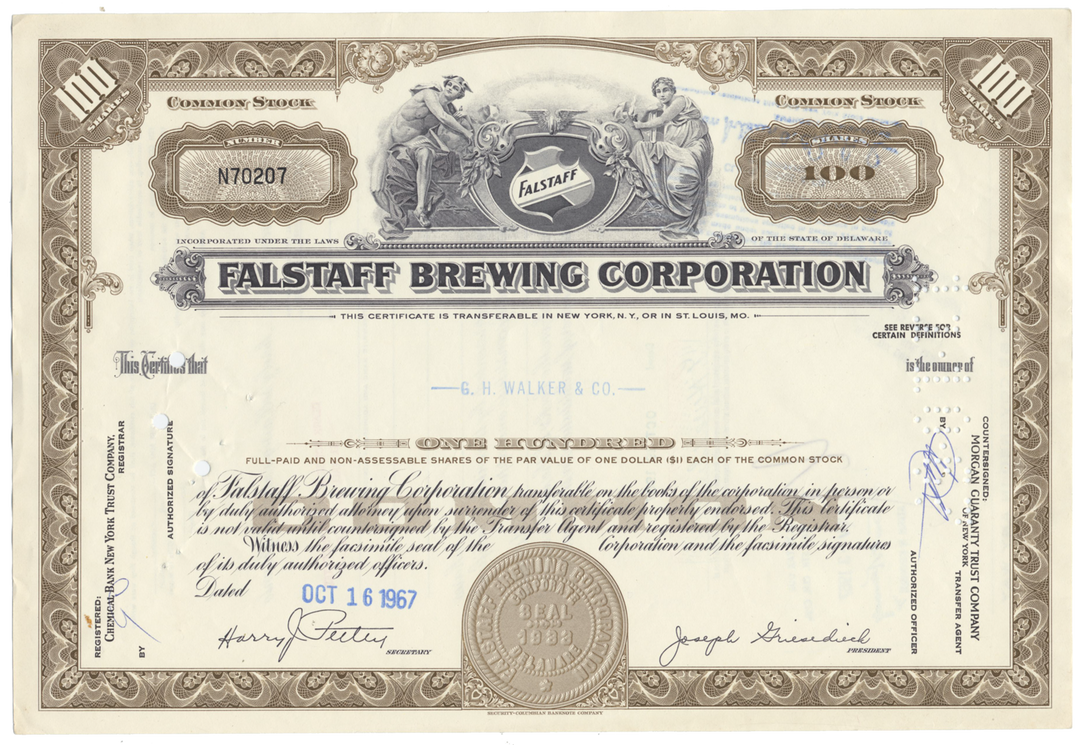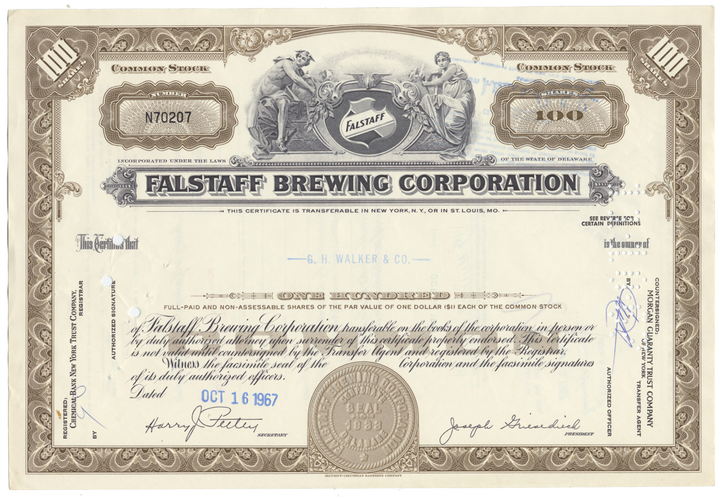Falstaff Brewing Corporation
- Guaranteed authentic document
- Orders over $75 ship FREE to U. S. addresses
Product Details




Certificate Type
Common Stock
Date Issued
1960's and 1970's
Canceled
Yes
Printer
Security-Columbian Bank Note Company
Signatures
Machine printed
Approximate Size
12" (w) by 8" (h)
Additional Details
NA
Historical Context

In 1840, Adam Lemp established the Western Brewing Company in order to brew lager beer for the large German immigrant population in St. Louis. The natural cave system below St Louis provided the perfect temperature for aging beer. He installed 20 thirty barrel oak casks in the caves to store the beer. Initial capacity of the brewery was only 100 bbl per year and it was located on 112 S. Second Street. The buildings were eventually torn down to make way for the famous St. Louis arch.
By 1879, Lemp is the 10th largest brewery in the US, ahead of Anheuser-Busch, but smaller than P Ballantine & Sons of Newark, New Jersey which Falstaff later acquired.
In 1889, Lemp launched their own railway company, the Western Cable Railway Company, as a result, Lemp Brewing became the first to distribute nationally. 500 refrigerated (by ice) railroad cars were used, and the brewery employed 700 men. Over 100 horses were required to pull the 40 delivery wagons for local deliveries. Lemp was now the 8th largest beer maker in the country, producing 500,000 bbl per year. Eventually the beer was sold in South America, Europe, Asia, and Australia.
In 1896, Lemp introduced the Falstaff shield trademark to protect his brand from imitators. The official story was that the design for the shield was derived from an artist's paint pallet.
A year later, Hilda Lemp married Gustav Pabst of Pabst Brewing Company, uniting two of the largest brewing families in America.
In 1903, Lemp Brewing registered the Falstaff trademark & logo. Lemp thought the Shakespearean character of Sir John Falstaff represented the more positive social aspects of drinking, rather than the destructive consequences of over consumption emphasized by prohibitionists. Sir John was a "man's man" who's philosophy was to "eat drink & be merry” and his sense of good fun was tempered by an exceptional intellect.
In 1923, in an attempt to bolster Falstaff's sagging fortunes, a portion of the plant was equipped to cure and smoke hams and bacon, and for a time the products found a ready market in St. Louis. The operations took advantage of the refrigeration units in the brewery. With rising pork prices and dwindling profits, the project was eventually abandoned.
In 1933, after surviving through prohibition by selling near beer, Falstaff Corporation became the Falstaff Brewing Corporation and was granted Federal Permit Number 1 to resume brewing beer. Huge crowds gathered on the front lawn outside the brewery on April 7 hoping to get a case of beer and the police had to be called in to control the mob. Some Falstaff employees worked 48 hours without sleep to keep up with the demand.
In 1951, Falstaff executives got the surprise of their lives on "Falstaff Day" when St. Louis Browns owner Bill Veeck staged a show at a double-header celebrating 50 years of the American League & Falstaff Beer. 18,000 fans crowded into the stadium and were all given Falstaff salt and pepper shakers. A large birthday cake was wheeled onto the field by an actor dressed as Sir John Falstaff and out jumped 3' 7", 65 lb. Eddie Gaedel, wearing number 1/8, who then pinch hits for Frank Saucier.
As his "strike zone" is only 1/2", Gaedel draws a walk, and is replaced by a pinch runner, and becomes the shortest player to appear in a game. The crowd, feeling no pain thanks to the Falstaff, absolutely loved it, and gave Eddie a standing ovation. Frank Saucier, on the other hand, was so upset about being replaced by Eddie that he resigned from professional baseball at the end of the season and never played again.
In 1963, Falstaff and Reynolds Aluminum introduced the Falstaff Tapper, a small keg which can hold about a case of beer. The tapper proved to be a marketing success but financial failure for Falstaff as the containers were not returned in sufficient quantities to recover the cost of manufacturing them. The same problem led to the elimination of returnable bottles by many brewers.
In the early 1970’s, Harry Caray became sportscaster for the Chicago White Sox and was sponsored by Falstaff. He previously had called the Cards games since 1944 for Griesedieck Bros. Brewing. His "Holy Cow! Have another Falstaff, folks!" became famous. At one point there was even a walking "Harry's Holy Cow" that strolled through the stadium with the Falstaff logo on his chest. Harry stayed with the Sox and Falstaff from '71 to '81, turning Comisky Park into "the world's largest outdoor saloon". Sadly, a change in Sox ownership from eccentric Bill Veeck to more "responsible" parties prompted a defection to Bud & the Cubs.
In 1990, the last brewery was closed (in Fort Wayne, Indiana), bringing the curtain down on the production of one the countries most storied beer makers.
Related Collections
Additional Information
Certificates carry no value on any of today's financial indexes and no transfer of ownership is implied. All items offered are collectible in nature only. So, you can frame them, but you can't cash them in!
All of our pieces are original - we do not sell reproductions. If you ever find out that one of our pieces is not authentic, you may return it for a full refund of the purchase price and any associated shipping charges.









